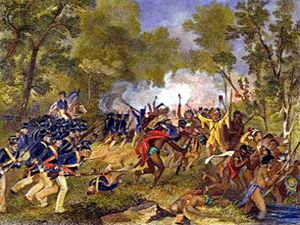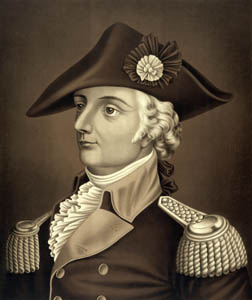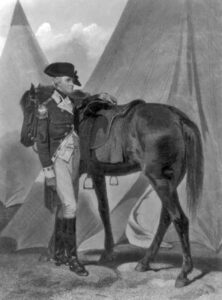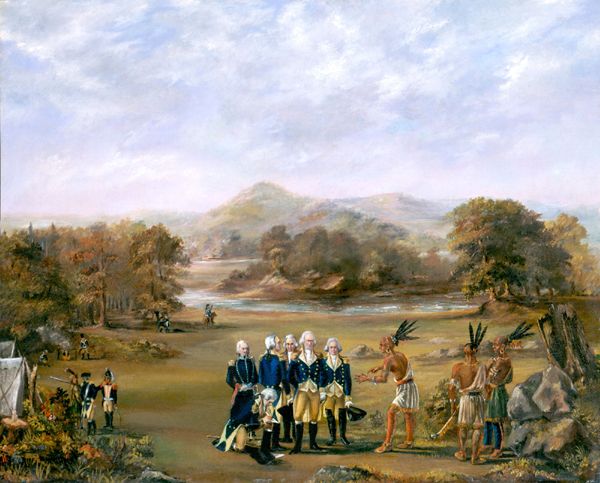Anthony Wayne was an American soldier, officer, politician, and one of the United States’ Founding Fathers. When the American Revolution began, he adopted a military career, where his military exploits and fiery personality earned him a promotion to brigadier general and the nickname “Mad Anthony.”
Wayne was born on his family’s 500-acre Waynesborough estate in Easttown, Chester County, Pennsylvania, on January 1, 1745, to Isaac and Elizabeth Iddings Wayne. His father, Isaac Wayne, who had immigrated to Easttown, Pennsylvania, from Ireland, built up the largest tannery in Pennsylvania and owned a profitable farm.
The oldest of four children, Anthony was educated in Philadelphia and became proficient in mathematics. During his upbringing, Wayne would clash with his father’s desire for him to be a farmer. His father served as a captain during the French and Indian War, leaving an impression on Wayne, who would mimic stories of battles at the time. Later, Anthony was educated as a surveyor at his uncle’s private academy in Philadelphia and the College of Philadelphia for two years. When he was 18, he commenced the business of surveying in his native town. Skill and popularity in his profession soon established his reputation permanently. In 1765, when he was only 20, Benjamin Franklin sent him and some associates to work surveying land granted in Nova Scotia for a year. He assisted with starting a settlement the following year at The Township of Monckton and was promoted to superintendent of the settlement. However, after remaining there for about two years, he returned home and resumed his business as a surveyor.
In 1766, he married Mary Penrose, and the couple would eventually have two children. However, the marriage would not be happy, as Wayne had romantic relationships with other women throughout his life, including Mary Vining, a wealthy woman in Delaware. These affairs led the couple to become estranged eventually.
In 1767, Anthony returned to work in his father’s tannery while continuing work as a surveyor. At the time, Wayne owned a 40-year-old male slave named Toby, registered in Chester County as a “slave for life.”
In 1774, after receiving the family farm in Chester County, Pennsylvania, he stepped into the political limelight as the Chester County Committee of Safety chairman before being elected into the Pennsylvania Provincial Assembly. He continued in that service until 1775, when he left the council for the field, having been appointed colonel in the Continental Army and helping to raise a Pennsylvania militia unit. During the Revolutionary War, he served in the Invasion of Quebec, the Philadelphia campaign, and the Yorktown campaign.
He accompanied General Thomas to Canada in the Spring of 1776, and at the close of service there, he was promoted to brigadier general. After a year of active service, he was engaged efficiently with the commander-in-chief in the battles at Brandywine, Germantown, and Monmouth, in all of which his skill and valor were conspicuous. Although his reputation suffered after his defeat in the Battle of Paoli, he won wide praise for his leadership in the 1779 Battle of Stony Point. During the night attack upon the strong fortress at Stony Point on the Hudson River, the entire garrison was made prisoners. It was one of the most brilliant achievements of the war, and Congress rewarded him with its thanks and a gold medal. It made him the most spoken in every part of the land.
In 1780, he was elected to the American Philosophical Society.
In 1781, General Wayne proceeded, with the Pennsylvania line, to Virginia, and there cooperated with Major General Marquis de Lafayette and Baron Friedrich Steuben against Benedict Arnold, the traitor who had invaded that state. Wayne’s retreat at Jamestown, Virginia, when almost surrounded by the British troops, was one of the most masterly performances ever accomplished. In the siege of Yorktown, he performed many deeds of great valor. After participating in the joy of the great victory there, he proceeded southward to prosecute the war in Georgia. He kept the British within their lines at Savannah until they were compelled to evacuate the state, and then Wayne, in triumph, took possession of the capital. For his great services there, the legislature of Georgia made him a gift of a valuable farm.

American Indians and the Continental Army.
After being promoted to major general in 1783, he soon retired from the Continental Army. Wayne settled on the Kew Plantation in Georgia that had been granted to him for his military service. He used slaves to manage his plantation. He briefly represented Georgia in the United States House of Representatives, where he faced controversy about his participation in electoral fraud.
In 1788, he was a member of the Pennsylvania Convention, called to consider the Federal Constitution, and was an earnest advocate.
In 1792, he was appointed to succeed General Arthur St. Clair in the command of troops in the Northwest Indian War.
In Ohio, he and his troops fought the Northwestern Confederacy, an alliance of several Native American tribes aided by the British. Wayne was tasked with organizing and training a proper fighting force and spent the first year building, training, and acquiring supplies. After a methodical campaign up the Great Miami and Maumee River Valleys.
Following the 1794 Battle of Fallen Timbers and a subsequent scorched earth campaign of destroying villages, he negotiated the Treaty of Greenville, ending the war. His victory during the Northwest Indian War resulted in the ethnic cleansing of Native Americans in the Ohio Valley. It helped pave the way for the future westward expansion of the United States under the doctrine known as manifest destiny. He then established Fort Wayne at the Miami capital of Kekionga in present-day Indiana.
On his return home, he was seized with gout and died in a hut at Presque Isle (now Erie, Pennsylvania ), in December 1796, at the age of 51 years. According to his request, he was buried under the fort’s flagstaff on Lake Erie’s shore. In 1809, his son, Isaac, had his body removed to Radnor churchyard in Delaware County, Pennsylvania. Over it, the Pennsylvania Society of Cincinnati erected a handsome marble monument with suitable inscriptions the same year.
Compiled and edited by Kathy Alexander/Legends of America, updated February 2024.
Also See:
Sources:
Lossing, Benson John; Eminent Americans, Volume II; American Publishers Corporation, New York, 1890.
Wikipedia



